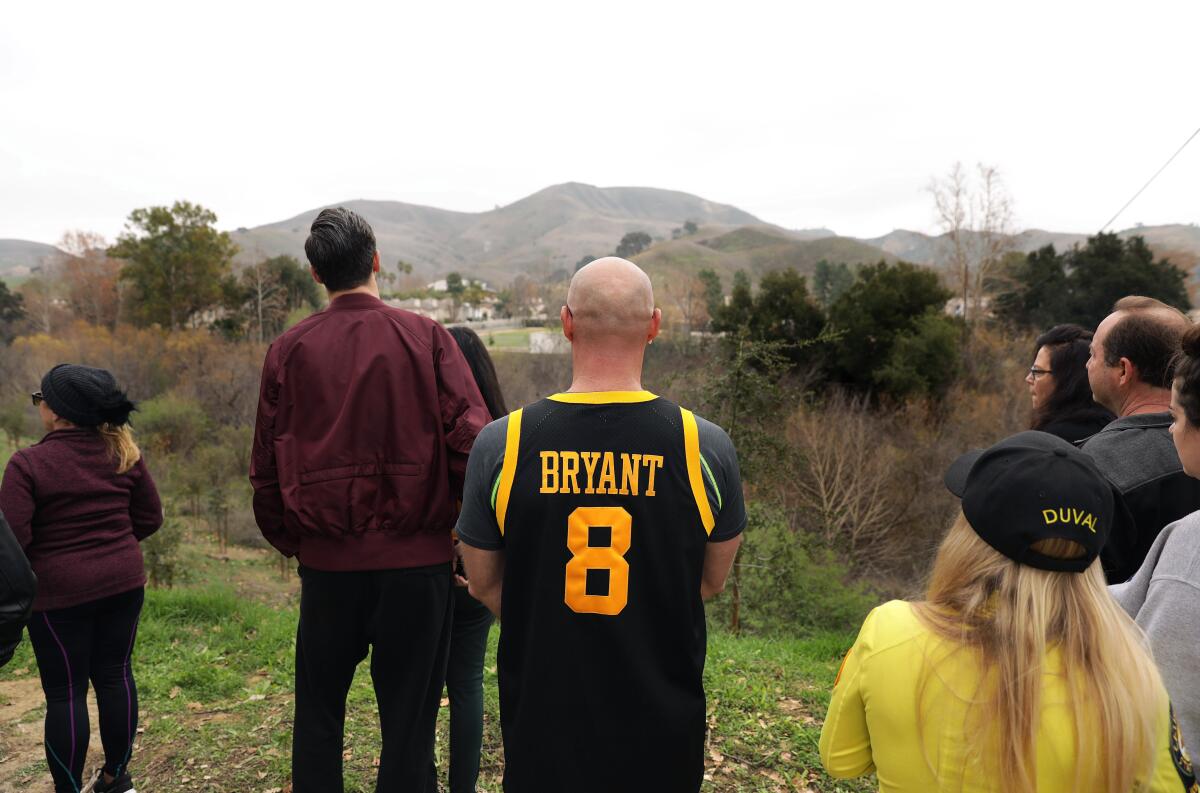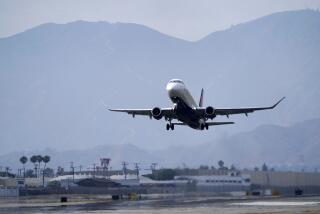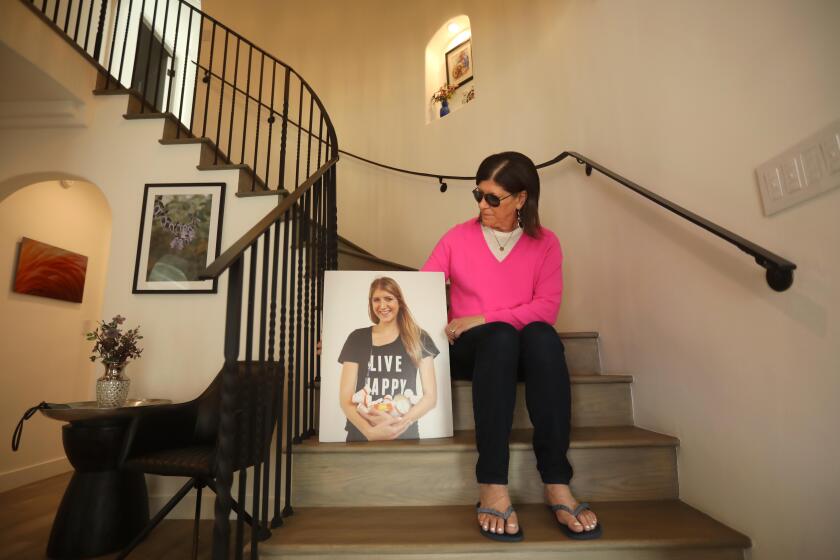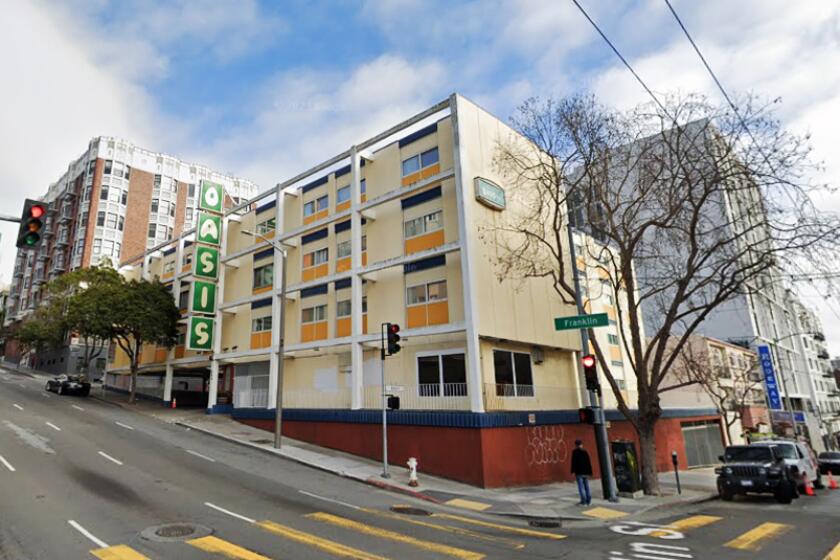Kobe Bryant helicopter crash caused by pilot’s poor decision making and disorientation, NTSB says

The pilot of a helicopter that crashed into a foggy Calabasas hillside one year ago, killing NBA legend Kobe Bryant and eight others aboard, should not have flown into cloudy conditions, where he became disoriented and lost control, federal investigators said Tuesday.
The National Transportation Safety Board determined the cause of the Jan. 26, 2020, crash was Ara Zobayan’s decision to fly under visual flight rules in cloudy conditions, which resulted in his spatial disorientation and loss of control of the aircraft. The board added that Zobayan’s “likely” self-induced pressure to get Bryant to his destination and inadequate review of safety management procedures by helicopter operator Island Express contributed to the crash.
Flying under visual flight rules through cloud cover was “legally prohibited,” yet Zobayan “continued his flight into clouds,” NTSB Chairman Robert Sumwalt said.
Zobayan, the NTSB noted, made a “poor decision” to fly at excessive speed in bad weather, and the helicopter was not in a controlled flight pattern when it crashed into the hillside near Las Virgenes Road and Willow Glen Street at 9:45 a.m.
NTSB member Michael Graham said Zobayan ignored his training, adding that as long as helicopters continue to fly into clouds while using visual flight rules “a certain percentage will not come out alive.”
Despite prior recommendations from the NTSB that helicopters be outfitted with crash-proof flight data and voice recorders, the Sikorsky that Bryant was flying on did not have such equipment. The Federal Aviation Administration did not require such features on the helicopter, nor was it required to have a safety management system.
NTSB investigator Bill English told the board that Zobayan informed air traffic control that he was “climbing to 4,000 feet” to get above the clouds. But English said the pilot was experiencing spatial disorientation because the helicopter banked to the left, away from the 101 Freeway, while communicating with the controller that it had descended.
Zobayan misperceived altitude and acceleration and suffered what is known as a somatogravic illusion, according to Dr. Dujuan Sevillian. He said the acceleration of the chopper could cause a pilot to sense the aircraft was climbing when it was not.
“Our inner ear can give us a false sense of orientation,” Sevillian said, noting that a lack of visual cues while being surrounded by clouds worsens the problem and the pilot suffers what is known as “the leans.”
Bryant and his daughter Gianna, along with several of her teammates, a few parents and coaches, took off shortly after 9 a.m. from John Wayne Airport in Orange County, heading to Camarillo Airport for the second day of a weekend tournament at the Mamba Academy in nearby Thousand Oaks. Also killed in the crash were Christina Mauser; Payton and Sarah Chester; John, Keri and Alyssa Altobelli; and Zobayan.
A witness who was on a mountain bike trail in Calabasas told investigators that the area was surrounded by mist and that he heard the sound of a helicopter and saw a blue and white chopper emerge from the clouds. NTSB investigators noted that videos and photos from the public depicted fog and low clouds obscuring the hilltops. Investigator English said the “weather did not sneak up on the pilot,” and board members noted he had an easy alternative of landing at Van Nuys Airport.
In the days following the crash, NTSB board member Jennifer Homendy said a terrain awareness system, or TAWS, would have provided more information to Zobayan, but she did not say whether it could have prevented the deadly crash.
Sumwalt, however, said Tuesday that the helicopter was not in controlled flight, and given that the pilot was disoriented, a terrain awareness system would not have helped him.
The NTSB board made 13 findings of fact, including that the pilot lost visual references in the clouds, made a poor decision to fly at excessive speed, and experienced spatial disorientation.
It also noted the pilot’s decision to fly that morning was probably influenced by internal pressure he felt based on his relationship with Bryant. Vice Chairman Bruce Landsberg said there is a long history of pilots who try to fulfill the requirements of a star, referencing previous crashes that killed music artists Buddy Holly, Patsy Cline, Aaliyah and Stevie Ray Vaughan.
The board found no evidence that Bryant ever pressured the pilot, but the relationship of trust likely made Zobayan feel the need to press on.
In its findings Tuesday, the board also said a fully implemented safety management system by Island Express would have helped and that flight data recorders could have provided vital information.
Investigators said the actions of air traffic controllers did not lead to the crash and rejected suggestions from Island Express to that effect. Island Express has sued the FAA, claiming its air traffic controllers were to blame for the crash.
The NTSB on Tuesday made recommendations to the FAA to improve helicopter safety, including implementing scenario-based training for changing weather conditions for helicopter pilots, and convening a panel of experts to “evaluate spatial disorientation simulation technologies to determine which applications are most effective for training pilots.”
It also recommended Island Express install flight data recording devices on each helicopter in its fleet.
The NTSB also reiterated a previous recommendation for helicopter manufacturers to install systems that record cockpit audio and images with a view of the cockpit environment to include as much of the outside view as possible.
“The recommendations that we issued today, if acted upon, will strengthen aeronautical decision-making skills related to weather ... and would result in research on spatial disorientation simulation training devices,” Sumwalt concluded.
The FAA on Tuesday said it takes NTSB recommendations “very seriously and will respond preliminarily to them within 90 days.”
The agency said in a statement that it requires safety management systems for scheduled airlines and is in the process of extending that to “on-demand/charter operators, operators conducting air tours and companies that design and produce aircraft engines or propellers.” It noted that it requires flight data monitoring systems for helicopters engaged in air ambulance operations and it is “reviewing the feasibility” of mandatory installation of such devices in other passenger aircraft.
The FAA noted it has done extensive research about spatial disorientation and holds a one-day physiological training course on stressors of flight that includes spatial disorientation. The agency added that Zobayan had “demonstrated the ability to recover from inadvertently flying into instrument meteorological conditions” during a May 2019 check ride with an FAA inspector.
Peter Goelz, former managing director of the NTSB, said the cause of the crash was clear once mechanical issues were eliminated. He said a key takeaway from the hearing is that the way to save lives going forward is to know as much as possible about any air crash, and that means having flight recorders installed.
“With miniaturization and lower costs, there is no excuse for not having one in some form or another on every aircraft. It would be the biggest advance in safety,” he said.
After the hearing concluded, Homendy tweeted that the board’s flight data monitoring recommendations were first issued in 2009, and recommendations on recorders were first issued in 1999. She urged the FAA to work with the NTSB “to change the future” and “save lives.”
“Every day, since Jan 26, 2020, I’ve thought about the 9 lives lost in Calabasas, just as I do the lives lost in so many other tragedies,” she said in another tweet. “To the families: Your loved ones will never be forgotten. We’ll continue to fight for them & the changes needed to prevent another crash.”
More to Read
Start your day right
Sign up for Essential California for news, features and recommendations from the L.A. Times and beyond in your inbox six days a week.
You may occasionally receive promotional content from the Los Angeles Times.







